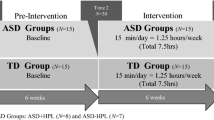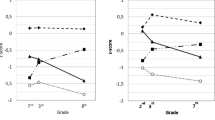Abstract
A portion of children with Autism Spectrum Disorder (ASD) exhibit a strength in early word reading referred to as hyperlexia (HPL), yet it remains unclear what mechanisms underlie this strength. Typically developing children (TD) acquire phonological awareness, alphabet knowledge and language skills as precursors to word reading. We compared these skills across English-speaking preschoolers with ASD, both with and without hyperlexia, and TD preschoolers. Findings indicated that the group with both ASD and HPL (ASD + HPL) exhibited advanced word reading and letter naming skills as compared to the other two groups, but did not demonstrate commensurate phonological awareness, letter-sound correspondence, or language skills. Findings support an alternative, non-phonological approach to early word reading in preschoolers with ASD and hyperlexia.



Similar content being viewed by others
Change history
15 September 2020
A Correction to this paper has been published: https://doi.org/10.1007/s10803-020-04688-w
Notes
Newman et al. (2007) had four preschoolers aged 5 years and younger mixed with 16 school-aged and adolescents (M=10.41 years, range 3–19.75).
References
American Psychiatric Association. (2013). Diagnostic and statistical manual of mental disorders (5th ed.). Washington: American Psychiatric Association.
Anthony, J. L., & Francis, D. J. (2005). Development of phonological awareness. Current Directions in Psychological Science, 14(5), 255–259.
Atkin, K., & Lorch, M. P. (2006). Hyperlexia in a 4-year-old boy with autistic spectrum disorder. Journal of Neurolinguistics, 19(4), 253–269. https://doi.org/10.1016/j.jneuroling.2005.11.006.
Baio, J., Wiggins, L., Christensen, D. L., Maenner, M. J., Daniels, J., Warren, Z., et al. (2018). Prevalence of autism spectrum disorder among children aged 8 years. MMWR. Surveillance Summaries, 67(6), 1–23. https://doi.org/10.15585/mmwr.ss6706a1.
Baron-Cohen, S. (2006). The hyper-systemizing, assortative mating theory of autism. Progress in Neuro-Psychopharmacology and Biological Psychiatry, 30, 865–872.
Bonnel, A., McAdams, S., Smith, B., Berthiaume, C., Bertone, A., Ciocca, B., et al. (2010). Enhanced pure-tone pitch discrimination among person with autism but not Asperger syndrome. Neuropsychologica, 48, 2465–2475.
Bonnel, A., Mottron, L., Peretz, I., Trudel, M., Gallun, E., & Bonnel, A. M. (2003). Enhanced pitch sensitivity in individuals with autism: A signal detection analysis. Journal of Cognitive Neuroscience, 15, 226–235.
Brooks, B. L., Sherman, E. M. S., & Strauss, E. (2009). NEPSY-II: A developmental neuropsychological assessment, second edition. Child Neuropsychology, 16(1), 80–101.
Cardoso-Martins, C., & Ribeiro da Silva, J. (2010). Cognitive and language correlates of hyperlexia : Evidence from children with autism spectrum disorders. Reading and Writing, 23, 129–145. https://doi.org/10.1007/s11145-008-9154-6.
Carlsson, L., Norrelgen, F., Kjellmer, L., Westerlund, J., Gillberg, C., & Fernell, E. (2013). Coexisting disorders and problems in preschool children with autism spectrum disorders. The Scientific World Journal. https://doi.org/10.1155/2013/213979.
Carroll, J. M., Snowling, M. J., Hulme, C., & Stevenson, J. (2003). The development of phonological awareness in preschool children. Developmental Psychology, 39(5), 913–923.
Carrow-Woolfolk, E. (2011). OWLS-II oral and written language scales - second edition: Foundations of language assessment. Torrance: Western Psychological Services.
Chaney, C. (1992). Language development, metalinguistic skills, and print awareness in 3-year-old children. Applied Psycholinguistics, 13, 485–514.
Constantino, J. M. (2012). Social responsiveness scale, second edition (SRS-2): Technical manual. Torrance: Western Psychological Services.
Davidson, M. M., & Weismer, S. E. (2014). Characterization and prediction of early reading abilities in children on the autism spectrum. Journal of Autism & Developmental Disorders, 44, 828–845.
Dynia, J. M., Brock, M. E., Justice, L. M., & Kaderavek, J. N. (2017). Predictors of decoding for children with autism spectrum disorder in comparison to their peers. Research in Autism Spectrum Disorders, 37, 41–48. https://doi.org/10.1016/j.rasd.2017.02.003.
Ehri, L. C. (2009). Learning to read words: Theory, findings, and issues. Scientific Studies of Reading, 9(2), 167–188. https://doi.org/10.1207/s1532799xssr0902_4.
Gabig, C. S. (2010). Phonological awareness and word recognition in reading by children with autism. Communication Disorders Quarterly, 31(2), 67–85.
Grigorenko, E. L., Klin, A., Pauls, D. L., Senft, R., Hooper, C., & Volkmar, F. (2002). A descriptive study of hyperlexia in a clinically referred sample of children with developmental delays. Journal of Autism and Developmental Disorders, 32(1), 3–12. https://doi.org/10.1023/A:1017995805511.
Harris, L. N., & Perfetti, C. A. (2017). Individual differences in phonological feedback effects: Evidence for the orthographic recoding hypothesis of orthographic learning. Scientific Studies of Reading, 21(1), 31–45. https://doi.org/10.1080/10888438.2016.1258702.
Heaton, P., Pring, L., & Hermlin, B. (1999). A pseudo-savant: A case of exceptional musical splinter skills. Neurocase, 5(6), 503–509. https://doi.org/10.1080/13554799908402745.
Hulme, C., Bower-Crayne, C., Carroll, J. M., Duff, F. J., & Snowling, M. J. (2012). The causal role of phoneme awareness and letter-sound knowledge in learning to read: Combining intervention studies with mediation analyses. Psychological Science, 23(6), 572–577. https://doi.org/10.1177/0956797611435921.
Kennedy, B. (2003). Hyperlexia profiles. Brain and Language, 84(2), 204–221. https://doi.org/10.1016/S0093-934X%2802%2900512-6.
Kenner, B. B., Terry, N. P., Friehling, A. H., & Namy, L. L. (2017). Phonemic awareness development in 2.5- and 3.5-year-old children: An examination of emergent, receptive, knowledge and skills. Reading and Writing, 30(7), 1575–1594. https://doi.org/10.1007/s11145-017-9738-0.
Kimhi, Y., Achtarzad, M., & Tubul-Lavy, G. (2018). Emergent literacy skills for five kindergartners with autism spectrum disorder: A Pilot Study. Journal of Research in Special Educational Needs, 18(3), 211–221.
Knight, E., Blacher, J., & Eisenhower, A. (2019). Predicting reading comprehension in young children with autism spectrum disorder. School Psychology Quarterly, 34(2), 168–177. https://doi.org/10.22201/fq.18708404e.2004.3.66178.
Korkman, M., Kirk, U., & Kemp, S. (2007). NEPSY-II: A developmental neuropsychological assessment (2nd ed.). San Diego: Harcourt.
Lamonica, D. A. C., Gejao, M. G., Prado, L. M., & Ferreira, A. T. (2013). Reading skills in children diagnosed with hyperlexia: Case reports. CoDAS, 25(4), 391–395.
Lanter, E., Watson, L. R., Erickson, K. A., & Freeman, D. (2012). Emergent literacy in children with autism: An exploration of developmental and contextual dynamic processes. Language, Speech, and Hearing Services in Schools, 43(3), 308–324. https://doi.org/10.1044/0161-1461(2012/10-0083).
Lin, C.-S. (2014). Early language learning profiles of young children with autism: Hyperlexia and its subtypes. Research in Autism Spectrum Disorders, 8(3), 168–177. https://doi.org/10.1016/j.rasd.2013.11.004.
Lord, C., & Rutter, M. (2012). Autism diagnostic observation schedule, second edition (ADOS-2): Technical manual. Torrance: Western Psychological Services.
Moody, E. J., Reyes, N., Ledbetter, C., Wiggins, L., DiGuiseppi, C., Alexander, A., et al. (2017). Screening for autism with the SRS and SCQ: Variations across demographic, developmental and behavioral factors in preschool children. Journal of Autism and Developmental Disorders, 47(11), 3550–3561. https://doi.org/10.1007/s10803-017-3255-5.
Mottron, L., Bouvet, L., Bonnel, A., Samson, F., Burack, J. A., Dawson, M., et al. (2013). Veridical mapping in the development of exceptional autistic abilities. Neuroscience and Biobehavioral Reviews, 37(2), 209–228. https://doi.org/10.1016/j.neubiorev.2012.11.016.
Mottron, L., Dawson, M., & Soulières, I. (2009). Enhanced perception in savant syndrome: Patterns, structure and creativity. Philosophical Transactions of the Royal Society B: Biological Sciences, 364(1522), 1385–1391. https://doi.org/10.1098/rstb.2008.0333.
Mottron, L., Dawson, M., Soulières, I., Hubert, B., & Burack, J. (2006). Enhanced perceptual functioning in autism: An update, and eight principles of autistic perception. Journal of Autism and Developmental Disorders, 36(1), 27–43. https://doi.org/10.1007/s10803-005-0040-7.
Nally, A., Healy, O., Holloway, J., & Lydon, H. (2018). An analysis of reading abilities in children with autism spectrum disorders. Research in Autism Spectrum Disorders, 47, 14–25. https://doi.org/10.1016/j.rasd.2017.12.002.
National Early Literacy Panel. (2008). Developing early literacy. Report of the national early literacy panel. Ed Pubs.
Needleman, R. (1982). A linguistic analysis of hyperlexia. In C. Johnson & C. Thew (Eds.), Proceedings of the second international congress for the study of child language - Volume I (pp. 473–481). Lanham: University Press of America Inc.
Newman, T. M., Macomber, D., Naples, A. J., Babitz, T., Volkmar, F., & Grigorenko, E. L. (2007). Hyperlexia in children with autism spectrum disorders. Journal of Autism and Developmental Disorders, 37(4), 760–774. https://doi.org/10.1007/s10803-006-0206-y.
O’Connor, N. O., & Hermelin, B. (1994). Two autistic savant readers. Journal of Autism & Developmental Disorders, 24(4), 501–515.
Ostrolenk, A., Forgeot d’Arc, B., & Mottron, L. (2018). Autistic children at the age of diagnosis are more interested in letters than typical children. The 17th International Society for Autism Research Conference [Poster presentation], Rotterdam, Netherlands. Retrieved from https://insar.confex.com/insar/2018/webprogram/Paper28551.html.
Ostrolenk, A., Forgeot d’Arc, B., Jelenic, P., Samson, F., & Mottron, L. (2017). Hyperlexia: Systematic review, neurocognitive modelling, and outcome. Neuroscience and Biobehavioral Reviews, 79, 134–149. https://doi.org/10.1016/j.neubiorev.2017.04.029.
Remington, A., & Fairnie, J. (2017). A sound advantage: Increased auditory capacity in autism. Cognition, 166, 459–465. https://doi.org/10.1016/j.cognition.2017.04.002.
Rutter, M., Bailey, A., & Lord, C. (2003). Social Communication Questionnaire (SCQ): Technical manual. Torrance: Western Psychological Services.
Saldaña, D., Carreiras, M., & Frith, U. (2009). Orthographic and phonological pathways in hyperlexic readers with autism spectrum disorders. Developmental Neuropsychology, 34(3), 240–253. https://doi.org/10.1080/87565640902805701.
Samson, F., Mottron, L., Soulieres, I., & Zeffiro, T. A. (2012). Enhanced visual functioning in autism: An ALE meta-analysis. Human Brain Mapping, 33(7), 1553–1581. https://doi.org/10.1002/hbm.21307.
Scarborough, H. S., & Brady, S. A. (2002). Toward a common terminology for talking about speech and reading : A glossary of the “ Phon ” words and some related terms. Journal of Literacy Research, 34(3), 299–336. https://doi.org/10.1207/s15548430jlr3403_3.
Schrank, F. A., Mather, N., & McGrew, K. S. (2014). Woodcock-Johnson tests of achievement - fourth edition (WJ-IV): Technical manual. Rolling Meadows: Riverside.
Schuele, C. M., & Boudreau, D. (2008). Phonological awareness intervention: Beyond the basics. Language Speech and Hearing Services in Schools, 39(1), 3. https://doi.org/10.1044/0161-1461(2008/002).
Share, D. L. (1995). Phonological recoding and self-teaching: Sine qua non of reading acquisition. Cognition, 55, 151–218.
Share, D. L. (1999). Phonological recoding and orthographic learning: A direct test of the self-teaching hypothesis. Journal of Experimental Child Psychology, 72(2), 95–129. https://doi.org/10.1006/jecp.1998.2481.
Silberberg, N. E., & Silberberg, M. C. (1967). Hyperlexia: Specificword recognition skills in young children. Exceptional Children, 34, 41–42.
Stanutz, S., Wapnick, J., & Burack, J. A. (2014). Pitch discrimination and melodic memory in children with autism spectrum disorders. Autism, 18(2), 137–147.
Talero-Gutierrez, C. (2006). Hyperlexia in Spanish-speaking children: Report of 2 cases from Colombia, South America. Journal of the Neurological Sciences, 249(1), 39–42. https://doi.org/10.1016/j.jns.2006.05.058.
Wechsler, D. (2012). Wechsler preschool and primary scale of intelligence-Fourth Edition: Canadian (WPPSI-IVCDN): Canadian technical manual. London: Pearson.
Westerveld, M. F., Paynter, J., O’Leary, K., & Trembath, D. (2018). Preschool predictors of reading ability in the first year of schooling in children with ASD. Autism Research. https://doi.org/10.1002/aur.1999.
Westerveld, M. F., Paynter, J., Trembath, D., Webster, A. A., Hodge, A. M., & Roberts, J. (2017). The emergent literacy skills of preschool children with autism spectrum disorder. Journal of Autism and Developmental Disorders. https://doi.org/10.1007/s10803-016-2964-5.
Zhang, S., & Joshi, R. M. (2019). Profile of hyperlexia: Reconciling conflicts through a systematic review and meta-analysis. Journal of Neurolinguistics, 49, 1–28. https://doi.org/10.1016/j.jneuroling.2018.08.001.
Acknowledgments
Support for this research was provided by graduate fellowships to D.M. from the Organization for Autism Research (OAR); the Fonds de Recherche du Québec—Societé et Culture (FRQSC); the Centre for Research on Brain, Language and Music (CRBLM), and operational grants from McGill University’s William Dawson Scholar Program to E.M.Q. We would like to thank Emerging Minds, Ottawa, ON for the use of their office space; Bianca Mercadante, Research Assistant, and all the parents and their wonderful children who participated in this project.
Author information
Authors and Affiliations
Contributions
D.M and E.M.Q conceived and designed the study. D.M recruited participants and collected all the data. D.M and E.M.Q analyzed the data. D.M, E.M.Q and G.L wrote the paper. All authors read and approved the final manuscript.
Corresponding author
Additional information
Publisher's Note
Springer Nature remains neutral with regard to jurisdictional claims in published maps and institutional affiliations.
The original version of this article was revised: the format error in Table 6 was corrected.
Appendix
Appendix
Rights and permissions
About this article
Cite this article
Macdonald, D., Luk, G. & Quintin, EM. Early Word Reading of Preschoolers with ASD, Both With and Without Hyperlexia, Compared to Typically Developing Preschoolers. J Autism Dev Disord 51, 1598–1612 (2021). https://doi.org/10.1007/s10803-020-04628-8
Published:
Issue Date:
DOI: https://doi.org/10.1007/s10803-020-04628-8




